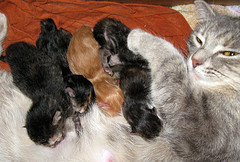
When Your Cat Is Having Kittens …
Discovering that your cat will be having kittens can be a daunting time – for both yourself and your pet. If you know what to expect while your cat is pregnant, you can help her to have a more straight-forward experience.
Here is our guide to your cat’s pregnancy.
Feline Pregnancies
Your cat’s pregnancy will last for between 58 to 70 days. This refers to the period from conception to birth.
Physically, it may not become obvious for around 5 weeks. You can expect to see pink nipples, followed by weight gain in the mid-section later on in the pregnancy. While your cat will put on weight, this will not necessarily be evident for some time. Her appetite will also increase at this point.
She may also spend more time sleeping and morning sickness can also become an issue. You may see a change in her personality too; many cats become more placid and affectionate while pregnant. She may also become more vocal and crave attention.
Before the Birth
Firstly, you should confirm your cat’s pregnancy with your vet. He or she can conduct an examination to make sure that your cat is in good health and discuss her vaccination history.
Continue with her normal diet for the most part. Discuss appropriate dietary needs with your vet, including how to get the right balance with feeding. A good diet is essential to ensure that your cat receives a range of nutrients for a healthy pregnancy.
You may be advised to combine specialist kitten food with regular diet to ensure that she gets an adequate calorie and calcium intake for her milk production. If she has a tendency to sleep through mealtimes, encourage her to wake up for food.
Her usual litter tray may not be suitable for her expanding stomach as the pregnancy progresses. This can cause her to avoid using it altogether. If she’s finding it difficult to get in and out of the litter tray, help her out by swapping it for a wider one with lower sides.
Around a month before the anticipated due date, set up a “nest” for your cat and fill this with shredded newspaper. Ideally, this “nest” should be put in an area that your cat is likely to go. In the run-up to the birth, she will cast around for a comfortable place to deliver and a “nest” can tick the right boxes.
During the Birth
Your cat’s body temperature will drop around 24 hours before the birth, followed by restless behaviour, loss of appetite and in some cases, vomiting. This stage typically lasts around 6 to 12 hours, at which point the cervix should become fully dilated. If there is no progress to the next stage of labour in 24 hours, or if you have any concerns seek medical assistance.
The second stage of birthing involves visible contractions, followed by the delivery of the first kitten. This should occur within a couple of hours. After each delivery, there may be a “resting” phase before the next kitten arrives. However, this may not happen and kittens will sometimes be born in quick succession. After each delivery, a placenta should also be ejected before the next arrival – there should be one placenta per kitten. If one or more does not come away, your cat could become seriously ill.
Keep an eye on the deliveries to make sure that everything is progressing normally but it’s best not to get directly involved unless it looks like something is going wrong. Stress and anxiety can have a very negative effect on the birth so it’s best to take a backseat as far as possible.
If you have any queries during the pregnancy or any concerns during delivery, please contact your vet for advice.
[Photo credit: elycefeliz]